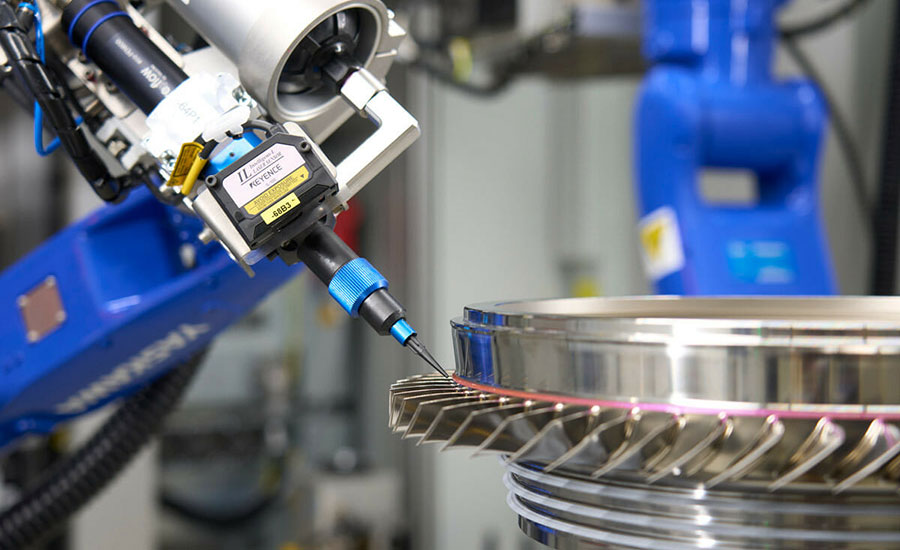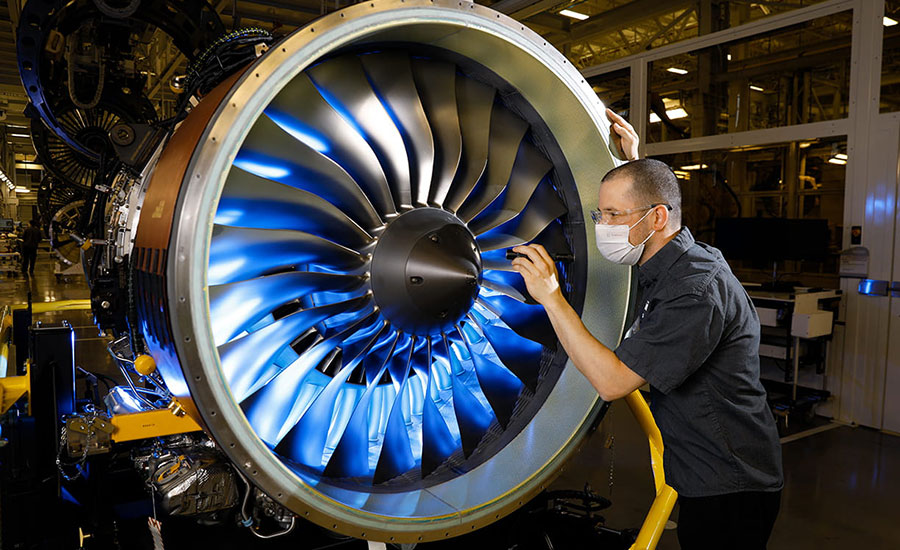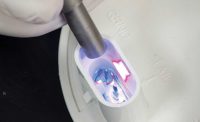When Thomas Kaltenecker, a production planner at MTU Aero Engines, wants to explain the purpose and utility of his new automating dispensing system, he places two photos side by side. The picture on the left shows a large storage facility with multiple floors of silicone rings in dozens of colors, shapes and sizes hung over, under and alongside each other. The picture on the right shows a few cartridges filled with a gel-like elastomer lying on a table.
“Ultimately, both fulfill the same task—namely, covering over certain areas of engine components with masking material while other areas that are subject to particularly strong stresses and strains are given, say, a thermal spray coating,” Kaltenecker explains. “The masking material makes sure the spray coating doesn’t get onto areas where it’s not supposed to be.”
Kaltenecker’s colleagues manually attach, fit and clamp the adhesive tape, silicone rings, masks or metal covers to these areas with a precision of less than a millimeter. By contrast, the fully automated dispensing system applies the elastomer to a component without human intervention. Then, a UV lamp cures the material in seconds. After the component passes through the process, whether it be thermal coating, shot blasting or electroplating, the maskant is pulled off the component without leaving residues behind.
Less Time, Improved Quality and Reduced Costs
The elastomer is SpeedMask from Dymax Corp. This company’s UV-curing adhesives, sealants and conformal coatings, are used in a variety of industries, including medical device and electronics manufacturing. Kaltenecker wondered if they could help his operation, as well.
Step by step, he began to experiment with SpeedMask. He tried out various material blends and masking processes using manual dispensing equipment. Initial tests yielded promising results. Gradually, he found himself spending more time not just planning production, but also developing a new masking technique. At the same time, student research projects were busy investigating elastomer 3D printing on engine parts. They attested to its technical feasibility and broad range of applications in MTU production.
The automated dispensing and curing system grew out of those efforts. As Kaltenecker tells his story, a blisk revolves in the robot cell behind him. The machine’s optics have recognized that it is dealing with the fourth stage of a specific high-pressure compressor. The control unit loads the corresponding program, sets up the correct dispenser and moves it into position. While the rotary table turns, tilts, lifts and lowers the component, an automatic dispensing valve continuously conveys elastomer from the cartridge. The valve applies the material precisely along the edges of the thin blisk blade tips. The machine can also fill drilled holes or apply maskant over broad areas. The system can accommodate numerous applications and variations.
“The exact shape of the specific mask is defined by the respective process parameters, such as the type of dispenser attachment, the distance and angle of the dispenser to the component, and the flow rate,” Kaltenecker explains.

The preeflow eco-PEN can dispense amounts as small as 0.001 microliter with an accuracy of ±1 percent. Photo courtesy Dymax Corp.
The dispensing valve is the preeflow eco-PEN from ViscoTec. The eco-PEN is a positive-displacement dispensing system that provides accurate and repeatable dispensing by means of a rotor that turns inside a stator. The device operates like a progressive cavity pump, dispensing a wide range of material viscosities with no stress to the material. The valve can dispense amounts as small as 0.001 microliter with an accuracy of ±1 percent. A slight reverse motion of the stator sucks back material at the tip, preventing drips and ensuring a clean cut-off of flow.
Once the material is in place on the parts, a UV lamp buzzes past and cures the elastomer. Finally, a vision system inspects the parts. “The system can spot, for example, whether there are unwanted little air bubbles or imperfections in the masking,” says Kaltenecker.
Better quality helps with the company’s sustainability goals, too. “Up to now, we’ve been rejecting around 14,000 silicone rings a year at incoming goods on account of deviations. These rejects end up as scrap,” says Kaltenecker.
From Prototype to Production
The prototype dispensing system was developed in the summer of 2022. After putting the system through testing, attention turned setting up the masking and curing programs for the first components.
“The prototype was definitely one of our most challenging projects to date,” explains Pascal Malischek, mechatronics and robotics engineer for Robooptic Systems, an integrator that helped develop the system. Based in Klagenfurt, Austria, Robooptic Systems specializes in vision systems, micro positioning and precision bonding applications.
“The machine’s entire control system is built in a modular design with free parameters, so that MTU can adapt the masking programs independently,” he says.
This programmability was important for MTU. Hundreds of different components pass through various coating stations during production. And, component geometries change in the course of design improvements. “In those instances, we have to be able to adjust the masking programs quickly and easily,” Kaltenecker says.
Now that the system is fully operational, the masking operation has become much more efficient. “The areas that need to be masked off have become so fine and intricate that masking them by hand takes huge concentration and an inordinate amount of time,” Kaltenecker says.

A worker inspects a jet engine for wear. Photo courtesy MTU Aero Engine
Tasks that took what felt like an eternity to do manually are now accomplished in a fraction of the time. “Especially now, with the sharp increase in production for the new programs, this is a big relief for colleagues,” Kaltenecker notes.
In some cases, the masking is applied just once and then used for several production steps. This saves a lot of time and money. For maintenance, repair and overhaul operations, custom programs can be set up for repairing worn engine parts.
The automated masking system is even opening up new potential in engine development.
“There are places inside the engine that developers would like to improve,” Kaltenecker explains. “But, some of their clever ideas were impossible for us to implement before now, because we were unable to get the masking done precisely enough with the adhesive tapes, silicone rings, masks and metal covers we were using.”
For more information on UV-cure adhesives and sealants, click here.
For more information on automated dispensing equipment, click here.



